Allograpta obliqua
Have you ever thought of the words “fly” and “beautiful” in the same sentence? No?!
Well, let me introduce you to Allograpta obliqua…
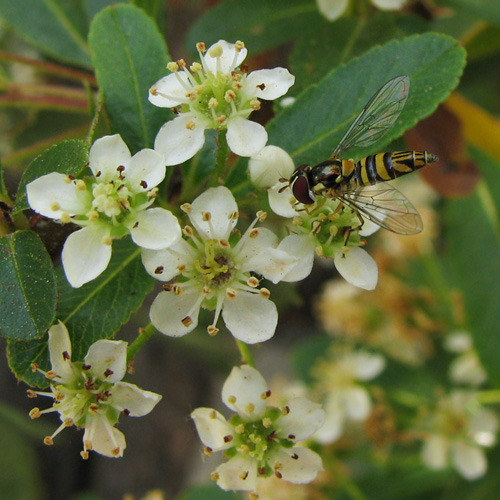 Nectaring on Pyracantha (Pyracantha angustifolia) flowers.
Nectaring on Pyracantha (Pyracantha angustifolia) flowers.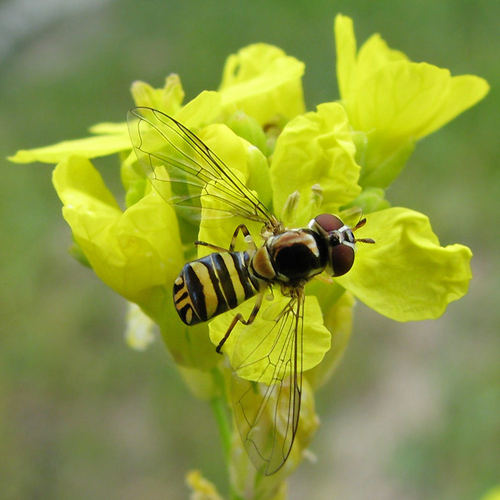 Nectaring on Mustard (Brassica sp.) flowers.
Nectaring on Mustard (Brassica sp.) flowers.
Allograpta obliqua can be found throughout much of North America and is a member of the family Syrphidae, collectively known as Flower Flies or Hover Flies. These names are very fitting as this fly visits a wide variety of flowers to collect nectar and is also an expert flyer with the ability to hover in one place, move sideways or backwards in flight. In addition to the fact that it is a joy to watch and is completely harmless to humans, this is a great fly to have around one’s garden. By visiting flowers it assists in pollination and it also lays its eggs on plants with aphid colonies, which are decimated by the fly’s predacious developing larvae.
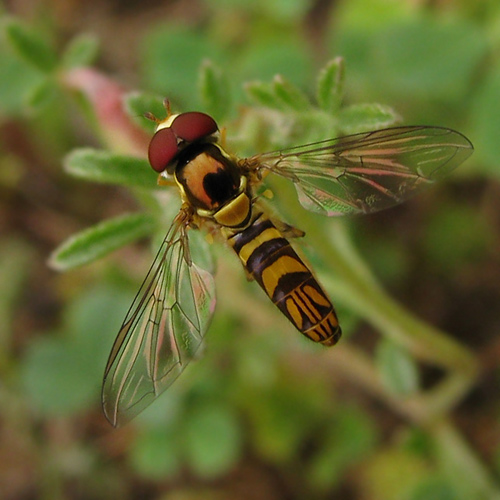 This is a male. See how its eyes come together and touch at the top of its head?
This is a male. See how its eyes come together and touch at the top of its head?
The females (as shown in the first and second photo) have eyes which are separated at the top.
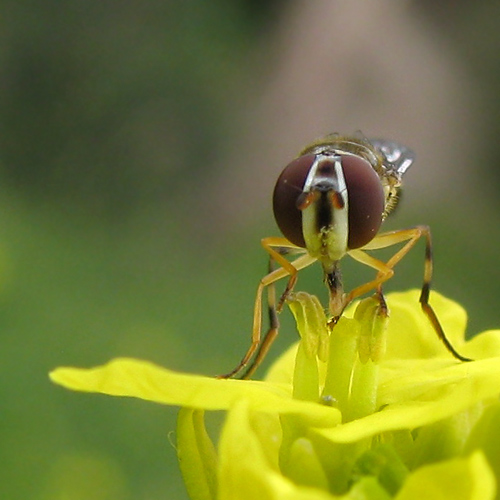 Here you can see the long mouthparts that the fly uses to effectively “lap up” the nectar and pollen.
Here you can see the long mouthparts that the fly uses to effectively “lap up” the nectar and pollen.
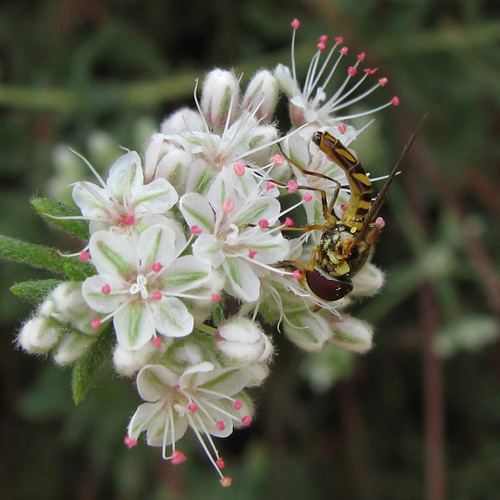 Nectaring on Buckwheat (Eriogonum sp.) flowers.
Nectaring on Buckwheat (Eriogonum sp.) flowers.
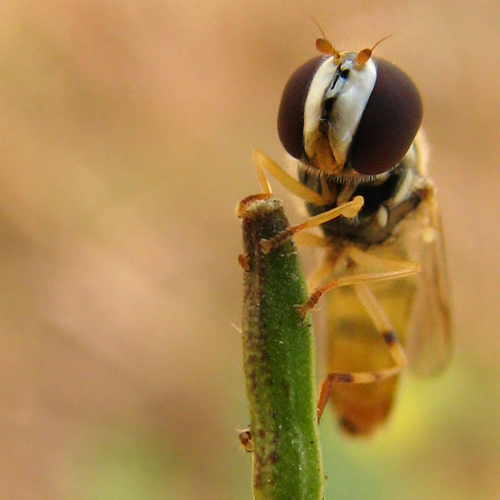 A face only a mother could love? *grin*
A face only a mother could love? *grin*
Well, I find them quite charming and they are a pleasure to photograph.
Check-out your garden or wildflowers along the trail for these endearing flies — they should be flying now!
Hi Harsi – I just learned more about these Hover Flies (as they are most commonly known here) by googling them :). It’s interesting that they have a single functional pair of wings since the hindwings are reduced to balancing organs. Thanks for sharing this today — the photos are wonderful. I like your “tip” too on telling the males and females apart. xoxo ~Lisa
Hey Harsi! Great photos of this one. Very fitting, too; I ran into this very syrphid earlier today while exploring the Bolsa chica wetlands (ran into atleast one other syrphid today as well, a Paragus sp. I believe). I don’t pay too much attention to flies in general, but it’s hard to overlook the syrphids (and bee flies too for that matter!) – perhaps, as you mentioned, among the most beautiful of the flies. ps: Is that your camera lens reflecting in the fly’s thorax in the second and third picture? 😉
~Lisa~ I’m so very glad that this post inspired you to learn about this family of flies!! (That is the best possible thing I could hope for from publishing this blog — that it prompts people to be curious and interested in the wildlife featured.) Keep reading — there will be plenty more fascinating insects to come!! xo ~Chris~ So cool that you were down at Bolsa Chica today… it’s been quite some time since I’ve gotten down there myself. We used to mostly go in order to birdwatch, so I’ve never gone hunting for insects there before. (See any other nifty critters besides syrphids?) If bet there are some really interesting plants in that specialized habitat… all I can remember is Pickleweed, but there must be many others?
Gosh what a beauty! I have never noticed these guys before, I must look closer, your photo’s are astonishing. You can bet I’ll be checking out the garden today. Thanks for the heads up. I agree with Lisa Bird, now I’ll know if i”m looking at a boy or girl. Have a wonderful weekend, xo
Ro, I have absolutely no doubt that your incredibly lush and lovely garden attracts droves of these flies! They are small and do take a bit of patience in approaching them — but, it’s soooo worth it. (Actually, cloudy cooler days like today are a great time to look because they aren’t quite as speedy.) With a lot of insects it is difficult (or near impossible) to tell what gender they are, but in the ones where it’s obvious like this, I always enjoy making the distinction. Then… after our photo session, I can say things like “Thank you so much, kind sir” or “Have a good day, lovely lady”. 🙂 🙂 🙂
Harsi – I went there mainly to check out the plantlife… many interesting species indeed, many new to me so I can’t give you any specific names yet (Calflora wasn’t working all yesterday). Arthropods came as an added bonus… if I can remember everything correctly, some of the other arthropods I saw were Argiope argentata (a really beautiful spider mostly on Prickley pear), Squash bugs (mostly on wishbone bush), an interesting thread-waisted wasp (Ammophila), as well as the usual suspects such as ground-wandering tenebs and flower-loving dasytinae. But I’ve heard that it is a good birding spot, I need to return there sometime to search for some birds 🙂
Sounds like you had an enjoyable and productive visit! I’ll keep an eye on your website and BugGuide to track the progress of your plant & arthropod IDs. A. argentata is INDEED a beautiful spider… I think I might have seen one once a loooong time ago, but it was before my insect interest had taken hold, so I didn’t pay very close attention. 🙁 There’s still stuff going on in the summertime at Bolsa Chica, but the birding gets really interesting there in Fall & Winter — prime time for all the ducks, shorebirds, pelicans, terns, etc.